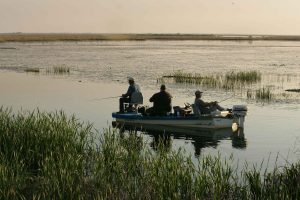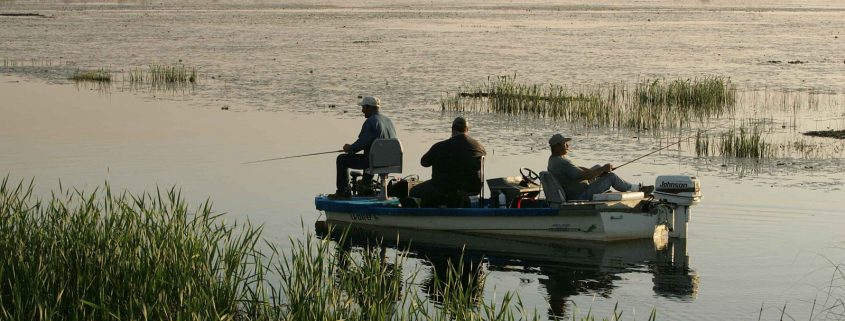Can Recreational Fishing Exist in Urban Societies?
By Emily Rose Nelson, RJD student
Recreational fishing is defined as “fishing of aquatic animals that do not constitute the individual’s primary resource to meet basic nutritional needs are not generally sold or otherwise traded on markets,” or simply put, fishing for fun. Anywhere from 220 to 700 million people participate in recreational fishing worldwide. At least 118 million of those people are from the modern industrial world, residing in North America, Europe, and Oceania. A recent study in Fisheries Management and Ecology attempts to explain the inconsistencies in recreational fishing participation rates across industrialized countries. Arlinghaus et al. performed a literature search identifying numbers of recreational fishers in a given country or state to test five different hypothesis regarding recreational fishing rates in industrialized and post industrialized countries.

Recreational fishing is used as a sport and way to relax by people across the globe. (Wikimedia Commons)
First, they showed that recreational fishing participation is positively related to the cultural importance (represented using total fish landings and per capita fish consumption) of fish in a given country. Countries that have long standing traditions of fishing as a primary food source or as a primary source of income through commercial operations place higher value on the activity. In these societies there is enhanced interest in fishing for recreation as time and resources become available. In addition, people are more likely to spend time fishing at a young age and pass the traditions onto their children. The overall culture of a society will form a general interest or lack of interest in fishing, however, culture is less important compared to other social factors in explaining recreational fishing participation.
Alringhaus et al. also showed that the availability of fishing opportunities is important in predicting the recreational fishing participation rates in a given country. Urban development has reduced the amount of unmodified land and water for activities like hunting and fishing. By changing the landscape, large portions of industrialized societies have been cut off from direct contact with nature and opportunities to participate in recreational fishing have declined. It is likely that younger generations in these areas will seek alternative activities in order to meet the same psychological needs that fishing would. By analyzing the relative surface area of freshwater, access to coastline, and number of recreational fishers it became clear that countries with higher water availability show higher recreational fishing rates. However, results were not significant and thus access to fishing opportunities has only minor influence on participation rates.

: In this image of Miami it is clear how the development of the city has limited access to the water. (Wikimedia Commons)
The third and fourth hypotheses were more strongly connected to the individual. The availability of resources in terms of time and money and perceived need for leisure of an individual were positively related to recreational fishing participation. The average age, average household size, and unemployment rate of a given society were used to represent availability of resources. Alringhaus et al. showed that increased age and increased financial constraints result in decreased recreational fishing participation. In societies where the average individual has ample physical, time, and financial resources recreational fishing rates are increased. In addition, individuals must have the interest and knowledge to partake in fishing in the first place. Using average weekly working hours as a proxy for an individual’s perceived need for leisure, the study showed that recreational fishing participation increases when people feel they need more time to relax. Fishing provides people with a temporary escape from the stress and commitments from every day life.
Of the multiple variables tested, the most important predictor of recreational fishing participation was urbanization. Population density and per capita gross domestic product were used to measure the urbanization and economy of a given society. Arlinghaus et al. showed that interest in recreational fishing initially rises with development but it then reaches a peak and starts to decline. Urbanization of a society involves a shift in overall values and opinions of wildlife and the environment. New values and norms are created that reduce the credence of fishing as a source of leisure and minimize the interest of the public in outdoor activities. The “videophilia hypothesis” argues that in developing societies nature based recreation is increasingly being pushed aside for electronic activities. As less active activities grow in popularity in urban societies recreational activities will be increasingly less active as well. Simply put, post- industrialization societies tend to have much lower recreational fishing participation rates.
Overall, it can be concluded that steady and increasing interest in recreational fishing will occur for societies in transition toward urbanization and economic development. However, in highly urbanized societies these rates are predicted to decrease. Management and marketing campaigns could be used to maintain fishing interest in years to come. In order for these efforts to be successful people must know where fishing opportunities exist, how to utilize these resources, and be able to do so at low costs. Without intervention urban societies will continue to participate in alternate leisure activities and lose connection with nature.
Arlinghaus, R., Tillner, R., & Bork, M. (2014). Explaining participation rates in recreational fishing across industrialized countries. Fisheries Management and Ecology, 22(1), 45-55




Thanks for a great summary of our work. It is spot on.